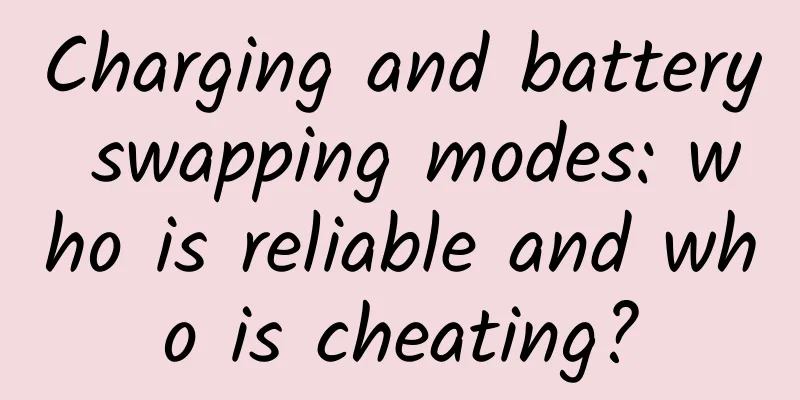Charging and battery swapping modes: who is reliable and who is cheating?

|
Even though it has suffered the double blow of the "subsidy fraud" incident and the decline in subsidies, the new energy vehicle industry is still vigorous. In October this year, the sales of new energy vehicles reached 30,989 units, an increase of 52% compared with 203,950 units in the same period last year. Faced with such a big "cake", it is unreasonable for profit-seeking businessmen to let it go. Nowadays, whether it is traditional car companies or new companies, even non-professional companies such as home appliances and the Internet are focusing on the new energy vehicle industry. However, the good performance cannot cover up the pain points of the industry. Apart from price, brand, performance and other issues, range anxiety is still the biggest obstacle to the development of new energy electric vehicles. This has also led to a dispute over the charging and battery replacement models of electric vehicles. In fact, the debate over the charging and swapping modes of electric vehicles is not new, but there is still no standard or expert to point out which technical route is more suitable for the current development situation. However, the industry is still discussing: Which charging and swapping mode of electric vehicles is more reliable? See the current status of charging mode Regarding the battery swap model, the opposition believes that due to different manufacturers, different internal structures of electric vehicles, and differences in technological levels, the battery swap model becomes an unfeasible solution. In addition, we take electric buses and electric private cars as examples for model analysis. First, electric buses have a single model, a relatively fixed route, and do not need to carry a large number of batteries due to long battery life. Battery swap stations can be built at the terminal, which can reduce energy consumption and the purchase cost of each vehicle. However, for electric private cars, the battery swap model is difficult to implement because of the large number of models, different battery models and capacities, etc. Therefore, the charging model is more practical and reliable. However, the premise of adopting the charging mode is to have charging piles and charging stations that are widely distributed and have a sound use system. However, according to current survey data, charging facilities are not only inefficient, but also cannot keep up with the production speed of electric vehicles. In my country, the ratio of new energy vehicles to charging piles is about 8:1, which is far from the theoretical ratio of 1:1~1.2. Therefore, the slow construction of charging facilities directly hinders the promotion of new energy vehicles. The rise of battery swapping As the charging model cannot meet the current market demand, the battery swap model came into being. This model was first proposed by Israel's Better Place, and once became a hot topic in the industry, but eventually went bankrupt due to high investment costs and slow development. Due to reasons such as standards and conflicts of interest, the battery swap model has not been well promoted and popularized in China. However, as car companies continue to innovate in technology, the battery swap model has also ushered in opportunities in China. Recently, the first batch of 10 charging and swapping stations built by BAIC New Energy in cooperation with Sinopec, Aulton New Energy and Shanghai Electric Bus were officially put into use, covering a total of 8 districts and counties. At the same time, Lifan also announced the establishment of the first centralized energy station in Chongqing, which uses battery swapping technology to replace batteries in a few minutes. Doubts continue Although the battery swap model looks good, the reality is very bleak. Everything has two sides, and the electric vehicle charging and swap model is no exception. The first thing to mention is the advantages of the battery swap mode: 1. Convenient and fast. The battery replacement can be completed within 3-10 minutes. 2. Reduce costs. After large-scale centralized use, charging can be carried out during the low-peak hours in the middle of the night to save energy resources and reduce charging costs. 3. Easy to control. Centralized and professional charging and discharging control is conducive to extending the battery life, and car owners no longer need to worry about the battery life and quality. However, it also has many disadvantages: 1. A large amount of battery reserves are required, the industry scale is huge, and it is difficult to coordinate the industrial chain, which is not conducive to the promotion of electric vehicles. 2. Unified technical standards are needed, including unified battery manufacturing technology, standardization construction, energy supply network construction, urban planning and other issues. 3. It will increase the risk of instability in the connection structure between the battery and the vehicle. The electrode plug is prone to wear and sparking, causing safety problems, and frequent movement of the battery will cause damage to the frame. Let's take a look at the shortcomings of electric vehicle charging mode: 1. Long charging time. It takes nearly 8 hours to fully charge the battery in slow charging mode, and nearly half an hour in fast charging mode. 2. Low utilization rate. Not to mention the imperfect charging facilities, most charging piles are not well located and are idle or occupied, resulting in low charging utilization rate. 3. It is difficult for individuals to apply for the construction of charging piles. Individuals need to go through a complex approval process and pay high installation and construction fees. In addition, the difficulty of increasing the capacity of residential properties and the imperfect supporting policies are also the reasons why some electric car owners are stumped. summary: In the final analysis, it does not make much sense to worry about which model is more reliable, as both have certain advantages and disadvantages. The resurgence of the battery swap model is only a new operating model in the development of the new energy vehicle industry. Therefore, the editor believes that we are not discussing which model is better at the moment, but we should adopt the corresponding model according to the actual situation to promote the development of electric vehicles and meet consumer demand. As a winner of Toutiao's Qingyun Plan and Baijiahao's Bai+ Plan, the 2019 Baidu Digital Author of the Year, the Baijiahao's Most Popular Author in the Technology Field, the 2019 Sogou Technology and Culture Author, and the 2021 Baijiahao Quarterly Influential Creator, he has won many awards, including the 2013 Sohu Best Industry Media Person, the 2015 China New Media Entrepreneurship Competition Beijing Third Place, the 2015 Guangmang Experience Award, the 2015 China New Media Entrepreneurship Competition Finals Third Place, and the 2018 Baidu Dynamic Annual Powerful Celebrity. |
<<: Will artificial intelligence drive down house prices?
Recommend
Toyota considers acquiring technology companies to ensure autonomous driving
Toyota Motor President Akio Toyoda said on Wednes...
"Health from eating" series | Why do we often say "eat radish in winter and ginger in summer"? Uncover the mystery of Chinese medicine diet therapy
"Eat radish in winter and ginger in summer&q...
What should you do to plan an event that will go viral on WeChat Moments?
How to create an event that will go viral on WeCh...
A thorough explanation of the product logic behind the lucky draw
I just recently completed a lottery project, and ...
How to help children focus after a long vacation?
Summer vacation is almost over. Are your children...
How to promote and attract traffic in QQ group?
The QQ platform has huge marketing potential, wit...
13 Content Creation Tips to Increase Conversion Rates (with Case Details)
Improving content conversion rate is the demand o...
A must-read for beginners | Let’s talk about public accounts, service accounts, enterprise accounts, and mini programs.
Tencent’s mini programs have been doing things on...
My friend, you must have wasted more than half of your advertising budget...
A few days ago, I met a friend who worked on home...
A guide to hot topics during the Spring Festival. Let’s see how big brands conduct their Spring Festival marketing!
The Spring Festival is the most anticipated and i...
Tik Tok promotion and monetization operation tutorial!
This video software, which has become extremely p...
The most comprehensive guide to short video distribution on Tik Tok, Kuaishou, etc.!
In the Internet age, short videos are king. 2018 ...
How to effectively improve the conversion effect of information flow?
The cost remained at 180 a few days ago, why did ...
There is no public domain traffic in the world
2020 is also known as the "first year of the...
Is it reliable to use mobile phone software to repel mosquitoes?
Another summer is here, bringing with it scorchin...









